When scrolling down your Facebook feed, what kind of content catches your attention? Is it text, images, videos, or GIFs?
As your eyes scan through your feed, you stop, whether on purpose or not, if a visual holds your attention. Most of the time, if the visual is engaging, it gets a click, a comment, like, or share.
Visual marketing involves the use of videos, infographics, images, and charts to increase your reach and engagement.
Every marketer is fighting to catch and hold their audience’s attention. You want a consumer to not only see your content but read it and take some action.
It’s due to the effectiveness of visuals that images and videos are the most widely used types of content. 80% of marketers prefer using visual images when driving social media marketing campaigns, while 63% use videos.
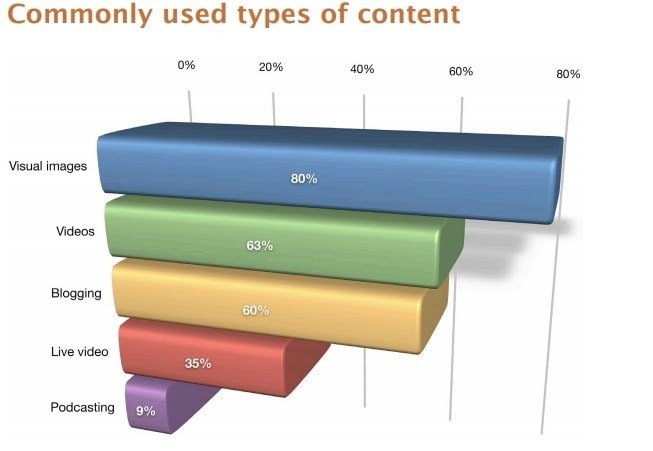
Image via Social Media Examiner
This post covers visual marketing facts that will help you design effective strategies. But first, let us understand what visual marketing is.
What is Visual Marketing?
Visual marketing involves the use of videos, images, graphics, logos, and other multimedia content. Visuals let you engagingly convey your information. They can be a great way to get the attention of your audience, even when they are only skimming through your article.
Marketers can leverage visuals to tell a brand’s story or to inform and educate their audience.
In the previously cited study, 68% of marketers said that they wanted to increase their use of visual images. Additionally, 77% and 63% of marketers said they wanted to use more videos and live videos, respectively.
Visual Marketing Facts: Why Your Business Needs It
If you’re still not convinced about the power of visual marketing, here are some facts that prove its benefits as a marketing strategy
1. People Prefer Visuals to Text
Reading long articles doesn’t catch the fancy of all consumers. Not everyone has the attention span for it. In fact, only 20% of readers finish reading an article. The average reader reads only 25% of an article.
Furthermore, 73% of respondents said in a survey that they have less time to give towards reading and research. However, they revealed that they were willing to spare over five minutes for interactive and visual content.
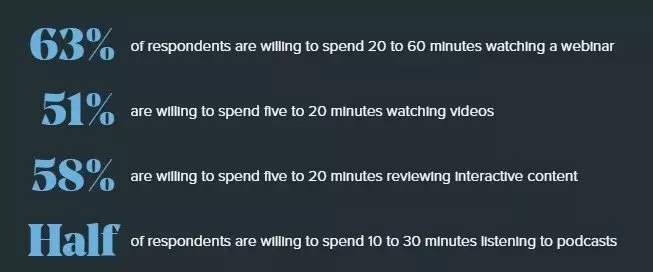
Image via Demand Gen
By having visuals as part of your content, you can capture the reader’s attention. They can help you break down complex subjects into an easy-to-understand form. This, in turn, can help you increase the time people spend on your website.
According to a survey by Infographic World, 61% of consumers voted infographics as the most effective form of content for learning and retaining information.
They help them think deeply about a subject, consider making purchases, discuss topics with their friends and family, and change opinions.
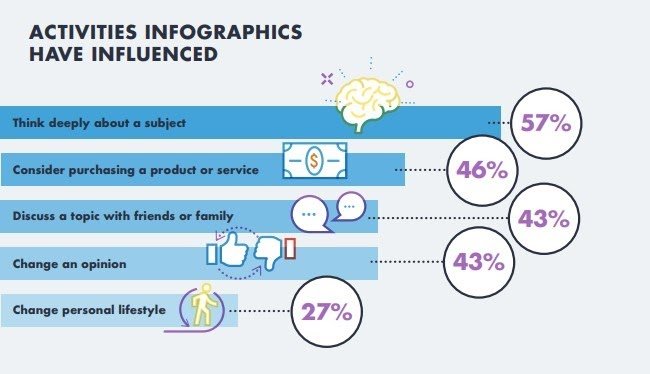
Image via Infographic World
When it comes to branded content, visuals win over text. Wyzowl found that 72% of consumers would rather watch a video than read text to find out more about a product or service.
HubSpot also found that 54% of consumers said they would like to see videos from companies or brands they support. A majority of the respondents also said that they preferred videos that were entertaining, funny, and informative.
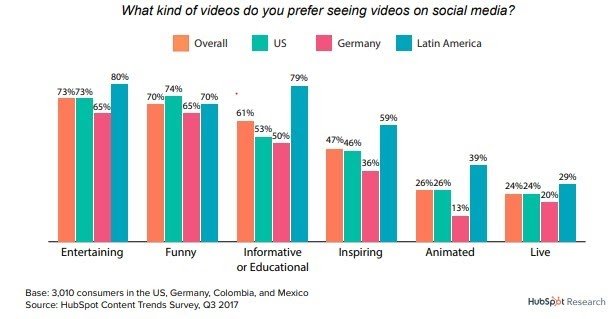
Image via HubSpot
When it comes to attention span, the length of your videos is also an important factor. According to Vidyard, only 25% of the audience will finish watching a video that is longer than 20 minutes. If you want to hold the attention of your audience with videos, keep them short.
Key Takeaways
Visuals can get you the attention of your audience. Instead of writing a lengthy article on how to use your product, opt for visuals. You could make a fun infographic with instructions on the process.
Alternatively, you could also create a video explaining the process. Just make sure that your videos aren’t too long.
2. Visual Marketing Increases Conversions
Facebook for Business found that 30% of US mobile shoppers consider video as the best medium to discover new products. In addition to this, 48% of Australians said that they had purchased a product after watching a branded video.
That’s all from Facebook. Google’s findings also reiterate this trend.

Think with Google also found that shoppers, overwhelmed by choices, turn to online videos for guidance on what to buy. They also found that:
People spend double the time watching YouTube videos on the topic “Which product to buy” year-over-year.
The total watch time for videos on YouTube related to the topic, “When to buy” has increased by 100%.
90% of shoppers have discovered new brands and products on YouTube.
60% of shoppers use online videos for inspiration and ideas for making purchases.
50% of shoppers revealed that online videos have helped them decide on which product or brand to purchase from.
50% of shoppers are likely to visit a store or consider buying a specific product if it is mentioned in a video online.
50% of shoppers stated that they used online videos while shopping in a store.
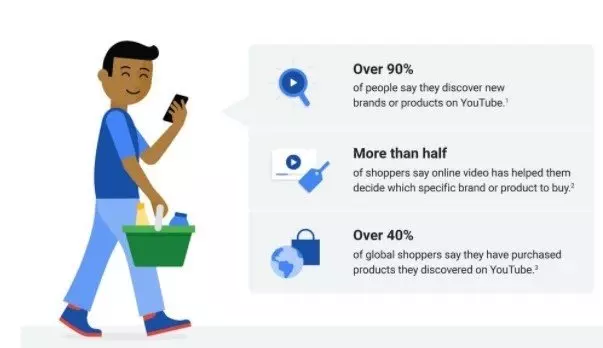
Image Source: Think with Google
Marley Spoon, a meal kit subscription service, tested this concept while trying to scale its advertising. They wanted to raise awareness and grow their customer base. They used a YouTube-only campaign, where they tailored every product explanation video to different audiences.
There was an ad showing how easy it is to use their service. Another one showed a family describing their experience in a humorous and emotive tone. They used different videos but with the same objective. They included calls-to-action at the end of each ad, encouraging viewers to “Sign Up” or “Try Now.”
Their brand awareness increased by 25%, while their branded search volumes increased 9.5 times. Subscriptions to their meal kit increased by 52% while ad recall grew by 49%.
Key Takeaways
Use great visuals to create brand awareness and a clear path to purchase. Identify user needs and create content to address these needs.
The visuals will capture consumer attention, engage, and inspire them. Include a call-to-action to encourage them to act. The holistic visual marketing strategy can deliver both long-term and short-term goals.
3. Visual Marketing Messages Get More Engagement
Adding value to visuals makes it easy for people to comprehend and engage with them. Animoto found that video is the favorite content format of consumers on social media. Additionally, 47% of them enjoy watching ads on Instagram Stories.
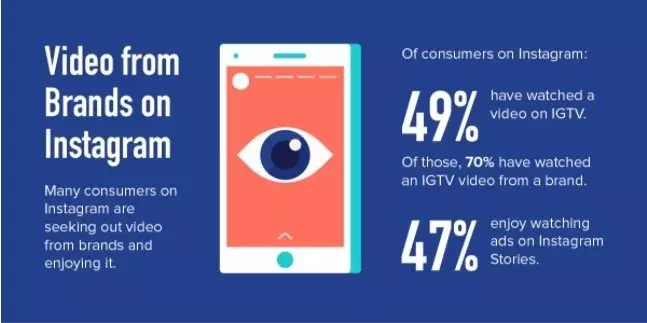
Image via Animoto
Brightcove found that videos drive consumer engagement. 53% of adult consumers engage with brands after viewing a video on social media. Additionally, 66% of millennials engage with brands after watching videos on social media.
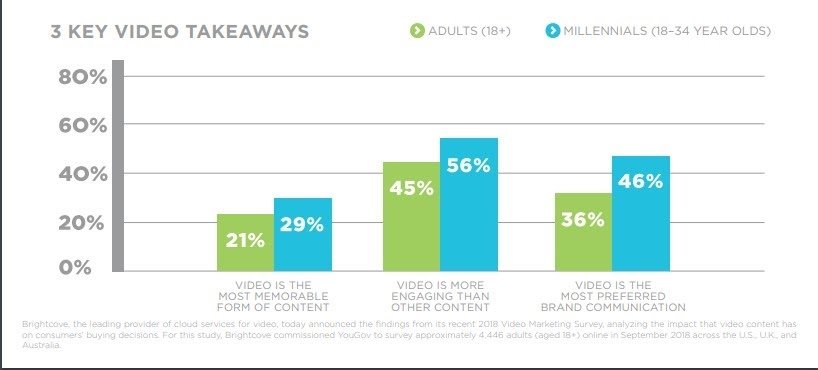
Image via Brightcove
Consumers also like to share visuals more than text with friends and family. 48% of them are likely to share video content with friends. On the contrary, only 23% of them said they’d share social media posts.
Key Takeaways
When choosing a visual to share on your social platforms, ask yourself:
- How will my audience react to the visuals?
- Do the visuals add value?
- Are they easy to understand?
- Does the image or video improve my message or explain it further?
- Is there a better visual I could use?
If in doubt, go back and choose a more relevant image or video.
When adding visuals, remember that they are not decorations. They are there to add value to your content and can make or break it. Don’t just add visuals to your marketing strategy because you need to.
Choose visuals that are worth sharing. Leverage content marketing software solutions to find images that are relevant to the content and your audience.
You want your audience to engage with your visual marketing messages, but they won’t if the content does not inspire them.
4. Visual Marketing Increases ROI
The ROI of visual marketing will be the revenue you make compared to money and time spent in creating or sourcing the visuals. This ROI does not only include sales made but also includes other metrics depending on your goals.
According to the same study by Animoto, 93% of businesses get a new customer through videos on social media. Additionally, 63% of them got their best social media ROI from video, while 56% got it from photos and graphics.
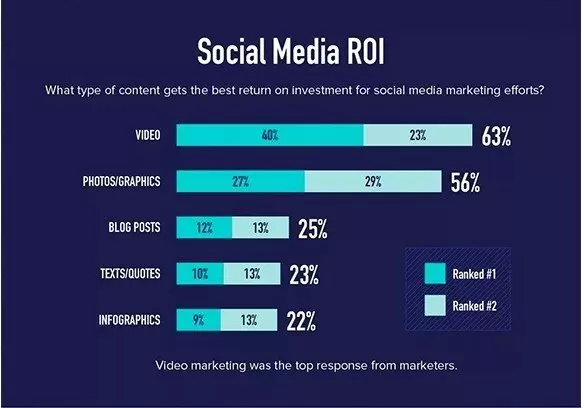
Image via Animoto
88% of marketers surveyed were also satisfied with the ROI of their video content. Additionally, 80% of them felt good about the ROI from video ads on social media.
The research also found that 64% of consumers made a purchase after viewing a video on Facebook. On the other hand, 48% of them purchased after watching videos on Instagram.
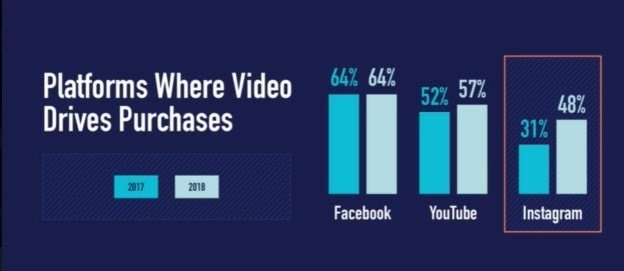
Image via Facebook
Key Takeaways
Visual marketing can help improve your ROI because it helps your brand grab the consumer’s attention and connect better with them.
Measuring the performance of your visuals empowers your strategy with insights on how your company can deliver value. Based on these insights, you can improve your offerings.
To measure what’s working and what’s not, you can use analytics tools. You should record the reach to know how far the message has spread ever since you started your visual marketing campaign.
How many unique visitors saw the visuals? What is the engagement rate? You must have answers to these questions. This data allows you to understand how the audience is engaging with your visual content.
5. Visual Marketing Drives Ecommerce Sales
Splashlight commissioned a survey which found that:
- 47% of American consumers rate high-quality images as the most important factor when purchasing from a specific brand online.
- Nearly 50% of US consumers want to see 3 to 5 product images, showing the back, front, and side of the product, before making a purchase
- 7% of online consumers find that model photos increase their likelihood of buying a product.
Key Takeaways
Consumers want high-quality product images that show them the different sides of a product. Product descriptions tell what the product can do, but visuals influence the consumer more. They show what the product looks like, and if you use high-quality images, you increase your chances of conversions.
Combine these high-quality images with the power of influencer marketing, and you can grow your sales drastically. The influencer provides social proof and trust, which can increase your conversion rate.
6. User-Generated Content Drives Visual Marketing
Bazaarvoice found that although photos and videos from brands drive awareness and brand recognition, they suffer consumer skepticism. 45% of online shoppers think that stock or studio images by brands exaggerate product claims.
However, consumer-generated videos or images are more likely to influence shoppers to purchase or try new products. These kinds of videos and photos are also the deciding factor when consumers are choosing between brands.
56% of shoppers say that other shoppers’ images and videos give them a better depiction of the brand experience.
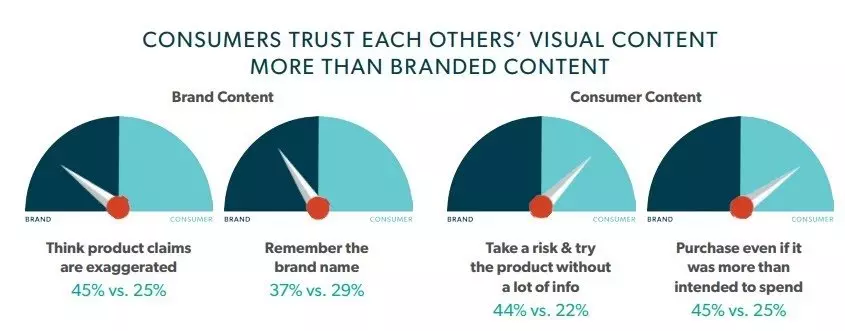
Image via Bazaarvoice
According to Stackla, user-generated content is 9.8x more impactful than content created by influencers. They also found that:
- UGC images were 1.8x more likely to make people interested in traveling than influencer content.
- 57% of consumers had made plans to dine at a restaurant based on videos or social images from family, friends, or peers.
- 45% of consumers found that customer-created visuals influenced their decision when purchasing a car.
- 54% of consumers bought consumer packaged goods based on videos or images from peers, friends, or family on social media.
Key Takeaways
User-generated visuals have an unmatched influence on target audiences. Consumers look for these visuals when making purchasing decisions.
Your brand cannot only rely on stock, staged, and influencer visuals to reach consumers. UGC can increase your authenticity and help you establish meaningful connections with your target audience.
Request that your customers share their experiences with your brand on social media and other review sites. Nearly 49% of consumers are willing to share positive reviews on social media or online. Additionally, 54% of millennial women also share positive reviews to get others to shop from a brand that offered positive experiences.
7. Visual Marketing Enables Visual Search
Visual search is one that uses real images or screenshots. For example, when you search for a style match on Pinterest or point a Google Lens camera at an object, you use visual search.
It answers questions that are a bit hard to verbalize. In 2017, the number of Google Image searches constituted nearly 27% of all searches.
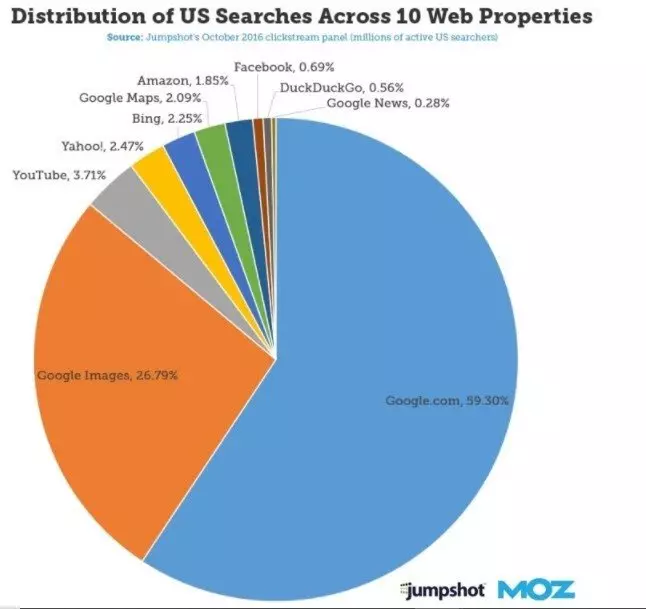
Image via Moz
eMarketer also found that millennial internet users were most comfortable with adopting visual search while shopping online.
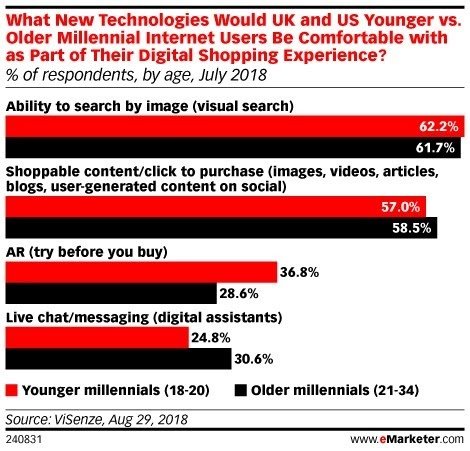
Image via eMarketer
Visual platforms like Pinterest saw nearly 600 million visual searches every month in 2018 through Pinterest Lens. People are embracing visual search to find products or images when they have a hard time verbalizing the search.
Key Takeaways
Visual search will accelerate in the coming years, and your brand needs to be a part of this trend. The accuracy of the searches has increased with the advent of image recognition tools and search engines that recognize visuals searches.
Marketers should optimize images for visual search by building an image library. Implement a strong SEO strategy that includes images. You should also have a strong brand presence on Pinterest and include metadata in your visual content’s information.
Conclusion
These visual marketing facts prove that you need visual marketing as part of your overall marketing strategy. However, prioritize quality over quantity to ensure that you create and publish engaging visuals. These can help you get more engagement and conversions.
It’s time to begin investing in visual marketing strategies if you haven’t already. The visuals will not only keep your brand relevant but also ensure that you stay ahead of trends and competitors.
What visual marketing fact did we miss out on? Tell us in the comment section below.
















Leave your comments
Post comment as a guest